steering Acura TL 2000 3.2 Owner's Guide
[x] Cancel search | Manufacturer: ACURA, Model Year: 2000, Model line: TL, Model: Acura TL 2000Pages: 311, PDF Size: 3.05 MB
Page 176 of 311
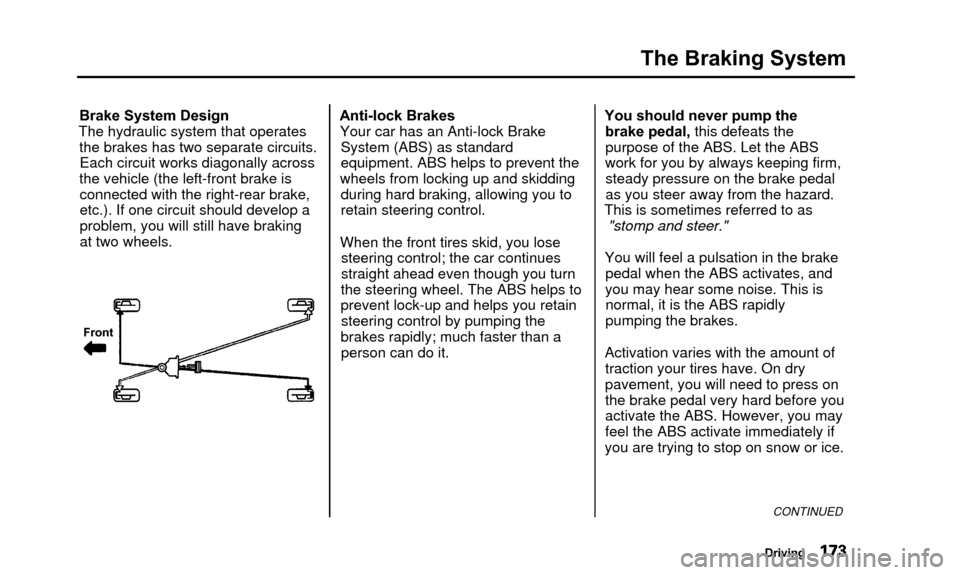
The Braking System
Brake System Design
The hydraulic system that operates the brakes has two separate circuits.Each circuit works diagonally across
the vehicle (the left-front brake is connected with the right-rear brake,
etc.). If one circuit should develop a
problem, you will still have brakingat two wheels.
Front
Anti-lock Brakes Your car has an Anti-lock Brake System (ABS) as standard
equipment. ABS helps to prevent the
wheels from locking up and skidding during hard braking, allowing you to
retain steering control.
When the front tires skid, you lose steering control; the car continues
straight ahead even though you turn
the steering wheel. The ABS helps to
prevent lock-up and helps you retain steering control by pumping the
brakes rapidly; much faster than a person can do it. You should never pump the
brake pedal, this defeats thepurpose of the ABS. Let the ABS
work for you by always keeping firm, steady pressure on the brake pedal
as you steer away from the hazard.
This is sometimes referred to as "stomp and steer."
You will feel a pulsation in the brake pedal when the ABS activates, and
you may hear some noise. This is normal, it is the ABS rapidly
pumping the brakes.
Activation varies with the amount of traction your tires have. On dry
pavement, you will need to press on
the brake pedal very hard before you
activate the ABS. However, you may
feel the ABS activate immediately if
you are trying to stop on snow or ice.
CONTINUED
Driving
Page 177 of 311

The Braking System
Important Safety Reminders
ABS does not reduce the time or distance it takes to stop the
vehicle, it only helps with steering control during braking. You should
always maintain a safe following
distance from other vehicles.
ABS will not prevent a skid that results from changing direction
abruptly, such as trying to take a
corner too fast or making a sudden
lane change. Always drive at a safe,prudent speed for the road and
weather conditions. ABS cannot prevent a loss of
stability. Always steer moderately
when you are braking hard. Severe or sharp steering wheel movement
can still cause your car to veer into oncoming traffic or off the road.
A vehicle with ABS may require a longer distance to stop on loose or
uneven surfaces, such as gravel or
snow, than a vehicle without anti-
lock. Slow down and allow a greater
distance between vehicles under
those conditions.ABS Indicator
ABS INDICATOR
The ABS is self-checking. If anythinggoes wrong, the ABS indicator on
the instrument panel comes on (seepage 55). This means the anti-lock
function of the braking system has
shut down. The brakes still work like
a conventional system without anti-
lock, providing normal stopping
ability. You should have the dealer inspect your car as soon as possible.
Driving
Page 181 of 311
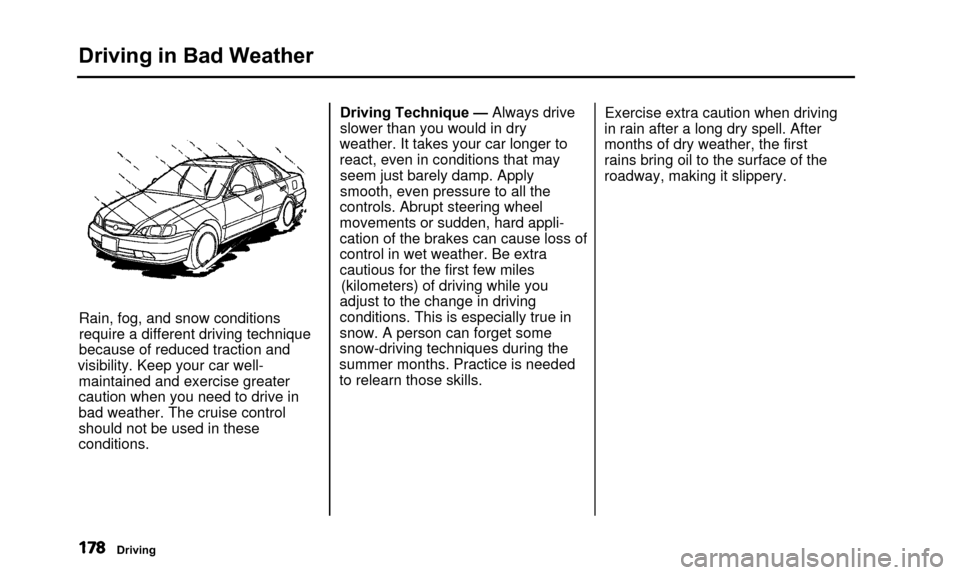
Driving in Bad Weather
Rain, fog, and snow conditions
require a different driving technique
because of reduced traction and
visibility. Keep your car well- maintained and exercise greater
caution when you need to drive in
bad weather. The cruise control
should not be used in these
conditions. Driving Technique — Always drive
slower than you would in dry
weather. It takes your car longer to
react, even in conditions that may seem just barely damp. Apply
smooth, even pressure to all the
controls. Abrupt steering wheel
movements or sudden, hard appli-
cation of the brakes can cause loss of
control in wet weather. Be extra
cautious for the first few miles (kilometers) of driving while you
adjust to the change in driving
conditions. This is especially true in
snow. A person can forget some
snow-driving techniques during the
summer months. Practice is needed
to relearn those skills. Exercise extra caution when driving
in rain after a long dry spell. After
months of dry weather, the first
rains bring oil to the surface of the
roadway, making it slippery.
Driving
Page 183 of 311

Towing a Trailer
Your Acura has been designedprimarily to carry passengers and
their cargo. You can use it to tow a
trailer if you carefully observe the
load limits, use the proper equipment, and follow the guidelines in thissection. Load Limits
• Total Trailer Weight: The total
weight of the trailer andeverything loaded in it must not
exceed 1,000 lbs (450kg).Towinga load that is too heavy can
seriously affect your vehicle's
handling and performance. It can also damage the engine and
drivetrain.
• Tongue Load: The weight that the tongue of a fully-loaded trailer
puts on the hitch should be
approximately 10 percent of the
trailer weight. Too little tongue
load can make the trailer unstable and cause it to sway. Too much
tongue load reduces front-tire
traction and steering control. To achieve a proper tongue load,
start by loading 60 percent of the
load toward the front of the trailer and 40 percent toward the rear, then
readjust the load as needed.
Driving
Page 189 of 311
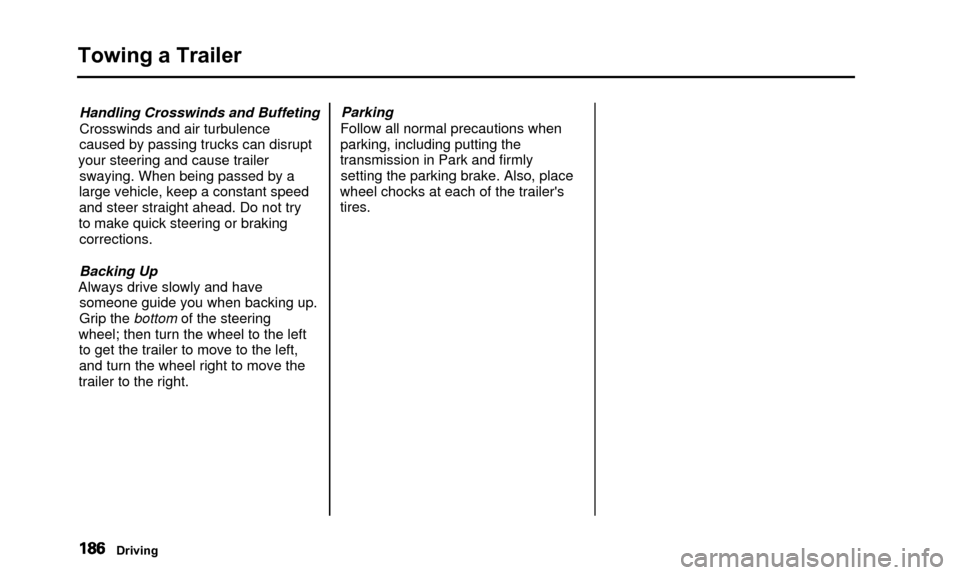
Towing a Trailer
Handling Crosswinds and Buffeting
Crosswinds and air turbulence
caused by passing trucks can disrupt
your steering and cause trailer swaying. When being passed by a
large vehicle, keep a constant speed
and steer straight ahead. Do not try
to make quick steering or braking corrections.
Backing Up
Always drive slowly and have someone guide you when backing up.
Grip the bottom of the steering
wheel; then turn the wheel to the left to get the trailer to move to the left,
and turn the wheel right to move the
trailer to the right. Parking
Follow all normal precautions when
parking, including putting the
transmission in Park and firmly setting the parking brake. Also, place
wheel chocks at each of the trailer's
tires.
Driving
Page 190 of 311
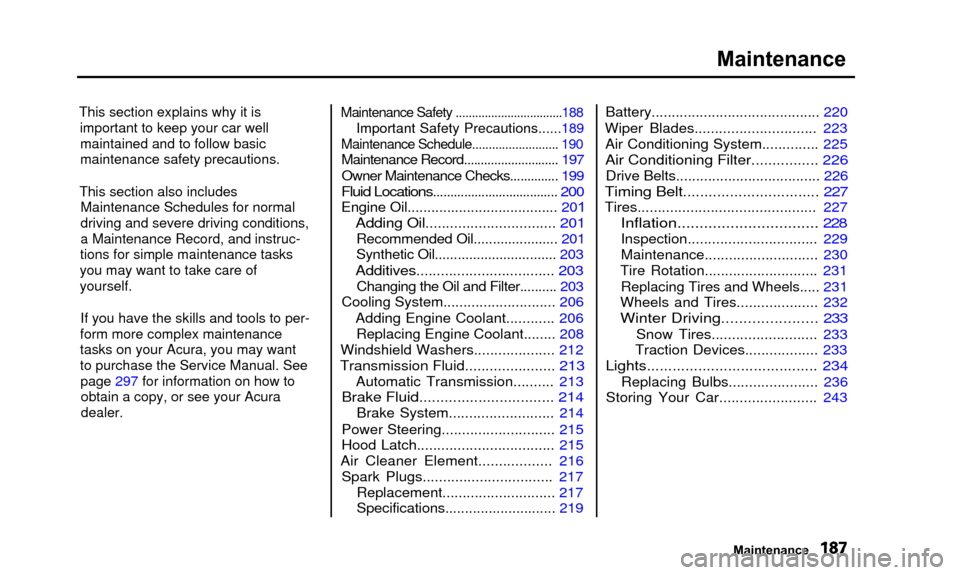
Maintenance
This section explains why it isimportant to keep your car wellmaintained and to follow basic
maintenance safety precautions.
This section also includes Maintenance Schedules for normal
driving and severe driving conditions,
a Maintenance Record, and instruc-
tions for simple maintenance tasks
you may want to take care of
yourself.
If you have the skills and tools to per-
form more complex maintenance
tasks on your Acura, you may want
to purchase the Service Manual. See page 297 for information on how toobtain a copy, or see your Acuradealer. Maintenance Safety .................................188
Important Safety Precautions......189
Maintenance Schedule
.......................... 190
Maintenance Record ............................ 197
Owner Maintenance Checks.............. 199
Fluid Locations.................................... 200
Engine Oil...................................... 201
Adding Oil................................ 201
Recommended Oil...................... 201
Synthetic Oil................................ 203
Additives.................................. 203
Changing the Oil and Filter.......... 203
Cooling System ............................ 206
Adding Engine Coolant............ 206 Replacing Engine Coolant........ 208
Windshield Washers .................... 212
Transmission Fluid...................... 213
Automatic Transmission.......... 213
Brake Fluid................................ 214
Brake System .......................... 214
Power Steering ............................ 215
Hood Latch.................................. 215
Air Cleaner Element .................. 216
Spark Plugs................................ 217
Replacement............................ 217
Specifications............................ 219Battery..........................................
220
Wiper Blades.............................. 223 Air Conditioning System.............. 225
Air Conditioning Filter................ 226
Drive Belts.................................... 226
Timing Belt................................ 227
Tires............................................ 227
Inflation................................ 228
Inspection................................ 229
Maintenance............................ 230
Tire Rotation............................ 231
Replacing Tires and Wheels..... 231
Wheels and Tires.................... 232
Winter Driving...................... 233
Snow Tires.......................... 233
Traction Devices.................. 233
Lights........................................ 234
Replacing Bulbs...................... 236
Storing Your Car........................ 243
Maintenance
Page 195 of 311
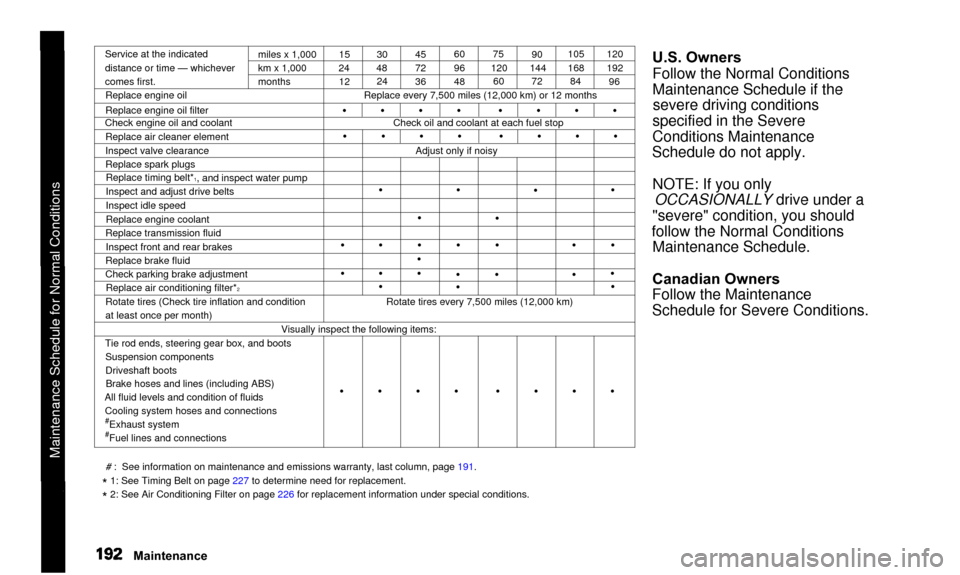
Maintenance Schedule for Normal Conditions
Service at the indicated
distance or time — whichever
comes first.miles x 1,000
km x 1,000
months
Replace engine oil
Replace engine oil filter
Check engine oil and coolant
Replace air cleaner element
Inspect valve clearance
Replace spark plugsReplace timing belt*
1, and inspect water pump
Inspect and adjust drive belts
Inspect idle speed
Replace engine coolant
Replace transmission fluid
Inspect front and rear brakes
Replace brake fluid
Check parking brake adjustment Replace air conditioning filter*
2Rotate tires (Check tire inflation and condition
at least once per month) 15
24
12 30
48 24 45
72
36 60
96
4875
120 60 90
144 72 105
168
84 120
192
96
Replace every 7,500 miles (12,000 km) or 12 months
Check oil and coolant at each fuel stop
•
•
Adjust only if noisy
•
•
•
• •
•
•
• •
•
•
• •
•
• •
•
• •
•
• •
Rotate tires every 7,500 miles (12,000 km)
Visually inspect the following items:
Tie rod ends, steering gear box, and boots Suspension components
Driveshaft bootsBrake hoses and lines (including ABS)
All fluid levels and condition of fluids Cooling system hoses and connections
#Exhaust system#Fuel lines and connections
U.S. Owners
Follow the Normal Conditions
Maintenance Schedule if thesevere driving conditions
specified in the Severe
Conditions Maintenance
Schedule do not apply.
NOTE: If you only OCCASIONALLY drive under a
"severe" condition, you should
follow the Normal Conditions Maintenance Schedule.
Canadian Owners
Follow the Maintenance
Schedule for Severe Conditions.
# : See information on maintenance and emissions warranty, last column, page\
191.
* 1: See Timing Belt on page 227 to determine need for replacement.
* 2: See Air Conditioning Filter on page 226 for replacement information under special conditions.
Maintenance
• • • • • •\
• •
• • • • • •\
• •
• • • • • •\
• •
Page 196 of 311
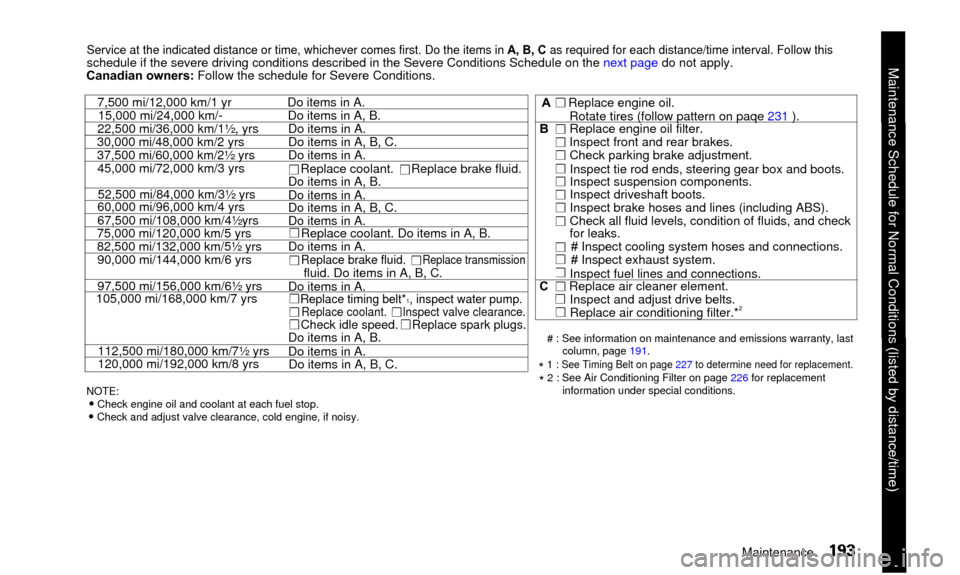
Maintenance Schedule for Normal Conditions (listed by distance/time)Service at the indicated distance or time, whichever comes first. Do the\
items in A, B, C as required for each distance/time interval. Follow thisschedule if the severe driving conditions described in the Severe Condit\
ions Schedule on the next page do not apply.
Canadian owners: Follow the schedule for Severe Conditions.
NOTE:• Check engine oil and coolant at each fuel stop.• Check and adjust valve clearance, cold engine, if noisy. # : See information on maintenance and emissions warranty, last
column, page 191.
* 1 : See Timing Belt on page 227 to determine need for replacement.
* 2 : See Air Conditioning Filter on page 226 for replacement information under special conditions.
Maintenance
7,500 mi/12,000 km/1 yr15,000 mi/24,000 km/-
22,500 mi/36,000 km/1½, yrs
30,000 mi/48,000 km/2 yrs
37,500 mi/60,000 km/2½ yrs 45,000 mi/72,000 km/3 yrs
52,500 mi/84,000 km/3½ yrs
60,000 mi/96,000 km/4 yrs
67,500 mi/108,000 km/4½yrs
75,000 mi/120,000 km/5 yrs
82,500 mi/132,000 km/5½ yrs
90,000 mi/144,000 km/6 yrs
97,500 mi/156,000 km/6½ yrs
105,000 mi/168,000 km/7 yrs
112,500 mi/180,000 km/7½ yrs
120,000 mi/192,000 km/8 yrs Do items in A.
Do items in A, B.Do items in A.
Do items in A, B, C.
Do items in A.
Replace coolant. Replace brake fluid.
Do items in A, B.
Do items in A.
Do items in A, B, C.
Do items in A. Replace coolant. Do items in A, B.
Do items in A.
Replace brake fluid. Replace transmissionfluid. Do items in A, B, C.
Do items in A.
Replace timing belt*1, inspect water pump. Replace coolant. lnspect valve clearance. Check idle speed. Replace spark plugs.Do items in A, B.
Do items in A.
Do items in A, B, C.
A Replace engine oil.
Rotate tires (follow pattern on paqe 231 ).
B Replace engine oil filter.
Inspect front and rear brakes.
Check parking brake adjustment.
Inspect tie rod ends, steering gear box and boots.
Inspect suspension components.
Inspect driveshaft boots.
Inspect brake hoses and lines (including ABS).
Check all fluid levels, condition of fluids, and check for leaks.
# Inspect cooling system hoses and connections.
# Inspect exhaust system.
Inspect fuel lines and connections.
C Replace air cleaner element.
Inspect and adjust drive belts.
Replace air conditioning filter.*
2
Page 197 of 311
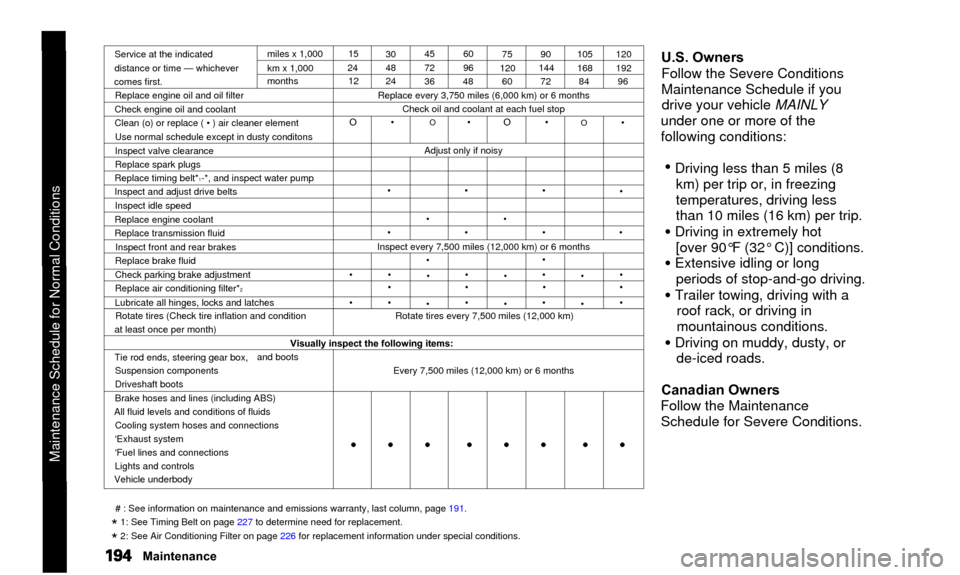
Service at the indicated
distance or time — whichever
comes first. miles x 1,000
km x 1,000
months
Replace engine oil and oil filter
Check engine oil and coolant
Clean (o) or replace ( • ) air cleaner element Use normal schedule except in dusty conditons
Inspect valve clearance
Replace spark plugs
Replace timing belt*
1-*, and inspect water pump
Inspect and adjust drive belts
Inspect idle speed
Replace engine coolant
Replace transmission fluid Inspect front and rear brakes
Replace brake fluid
Check parking brake adjustment
Replace air conditioning filter*
2Lubricate all hinges, locks and latches Rotate tires (Check tire inflation and condition
at least once per month) 15
24 12 30
48
24 45
72
3660
96
48 75
120 60 90
144
72 105
168
84 120
192
96
Replace every 3,750 miles (6,000 km) or 6 months Check oil and coolant at each fuel stop
O •
O • O •
Adjust only if noisy
•
•
•
•
•
•
•
•
O •
•
•
Inspect every 7,500 miles (12,000 km) or 6 months
•
• •
•
•
•
•
••
•
••
•
•
• •
•
•
••
•
•
Rotate tires every 7,500 miles (12,000 km)
Visually inspect the following items:
Tie rod ends, steering gear box, Suspension components
Driveshaft boots and boots
Brake hoses and lines (including ABS)
All fluid levels and conditions of fluids Cooling system hoses and connections
'Exhaust system
'Fuel lines and connections
Lights and controls
Vehicle underbody Every 7,500 miles (12,000 km) or 6 months
U.S. Owners
Follow the Severe Conditions
Maintenance Schedule if you
drive your vehicle MAINLY
under one or more of the
following conditions:
• Driving less than 5 miles (8 km) per trip or, in freezing
temperatures, driving less
than 10 miles (16 km) per trip.
• Driving in extremely hot[over 90°F (32° C)] conditions.
• Extensive idling or long periods of stop-and-go driving.
• Trailer towing, driving with a roof rack, or driving in
mountainous conditions.
• Driving on muddy, dusty, orde-iced roads.
Canadian Owners
Follow the Maintenance Schedule for Severe Conditions.
# : See information on maintenance and emissions warranty, last column, \
page 191.
* 1: See Timing Belt on page 227 to determine need for replacement.
* 2: See Air Conditioning Filter on page 226 for replacement information under special conditions.
Maintenance
Maintenance Schedule for Normal Conditions• • • • • • • \
•
Page 198 of 311
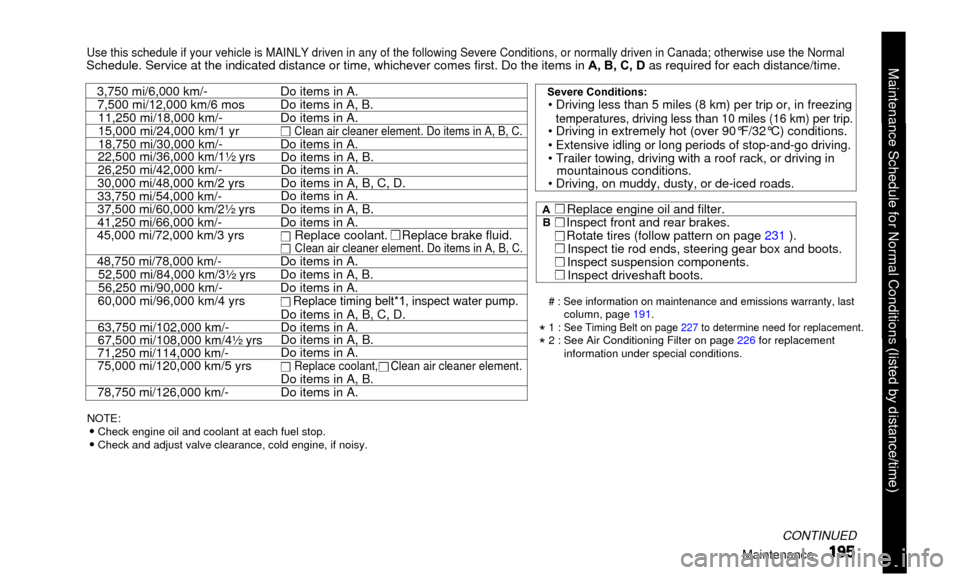
Use this schedule if your vehicle is MAINLY driven in any of the followi\
ng Severe Conditions, or normally driven in Canada; otherwise use the No\
rmalSchedule. Service at the indicated distance or time, whichever comes fir\
st. Do the items in A, B, C, D as required for each distance/time.
3,750 mi/6,000 km/-7,500 mi/12,000 km/6 mos 11,250 mi/18,000 km/-
15,000 mi/24,000 km/1 yr
18,750 mi/30,000 km/-
22,500 mi/36,000 km/1½ yrs
26,250 mi/42,000 km/-
30,000 mi/48,000 km/2 yrs
33,750 mi/54,000 km/-
37,500 mi/60,000 km/2½ yrs
41,250 mi/66,000 km/-
45,000 mi/72,000 km/3 yrs
48,750 mi/78,000 km/-
52,500 mi/84,000 km/3½ yrs
56,250 mi/90,000 km/-
60,000 mi/96,000 km/4 yrs
63,750 mi/102,000 km/-
67,500 mi/108,000 km/4½ yrs
71,250 mi/114,000 km/-
75,000 mi/120,000 km/5 yrs
78,750 mi/126,000 km/- Do items in A.
Do items in A, B. Do items in A.
CIean air cleaner element. Do items in A, B, C.Do items in A. Do items in A, B.Do items in A.
Do items in A, B, C, D.
Do items in A.
Do items in A, B.
Do items in A. Replace coolant. Replace brake fluid.
CIean air cleaner element. Do items in A, B, C.Do items in A.
Do items in A, B.
Do items in A.
'
Replace timing belt*1, inspect water pump.Do items in A, B, C, D.
Do items in A.
Do items in A, B.
Do items in A.
Replace coolant, Clean air cleaner element.Do items in A, B.
Do items in A.
NOTE:• Check engine oil and coolant at each fuel stop.• Check and adjust valve clearance, cold engine, if noisy.
CONTINUED
Maintenance
Severe Conditions:• Driving less than 5 miles (8 km) per trip or, in freezingtemperatures, driving less than 10 miles (16 km) per trip.• Driving in extremely hot (over 90°F/32°C) conditions.
• Extensive idling or long periods of stop-and-go driving.• Trailer towing, driving with a roof rack, or driving in mountainous conditions.
• Driving, on muddy, dusty, or de-iced roads.
A
B• Replace engine oil and filter. Inspect front and rear brakes.
Rotate tires (follow pattern on page 231 ). Inspect tie rod ends, steering gear box and boots.
Inspect suspension components. Inspect driveshaft boots.
# : See information on maintenance and emissions warranty, lastcolumn, page 191.
* 1 : See Timing Belt on page 227 to determine need for replacement.
* 2 : See Air Conditioning Filter on page 226 for replacement
information under special conditions.
Maintenance Schedule for Normal Conditions (listed by distance/time)